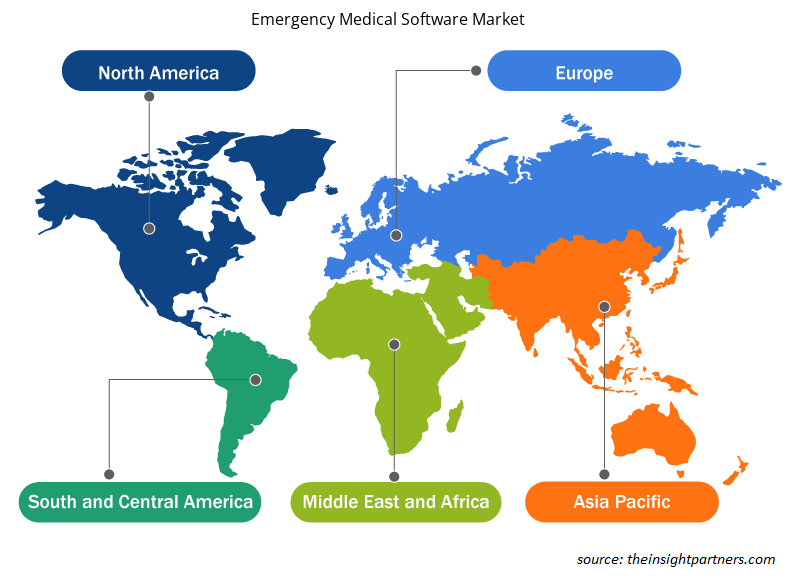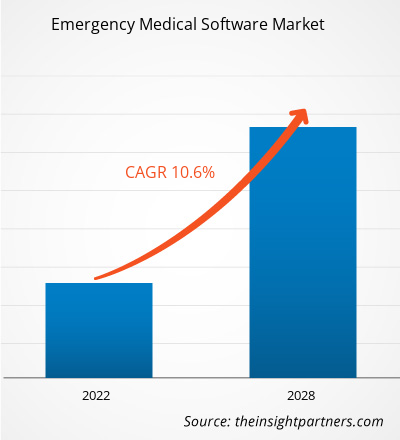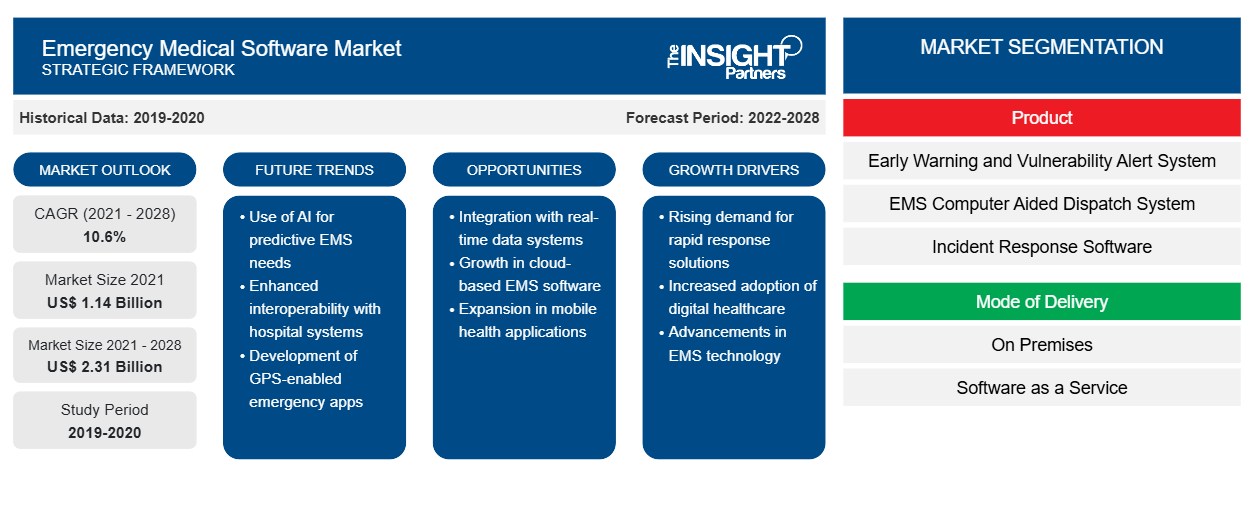من المتوقع أن يصل سوق برمجيات الطوارئ الطبية إلى 2،313.20 مليون دولار أمريكي بحلول عام 2028 من 1،144.91 مليون دولار أمريكي في عام 2021؛ ومن المتوقع أن ينمو بمعدل نمو سنوي مركب قدره 10.6٪ خلال الفترة 2021-2028.CAGR of 10.6% during 2021-2028.
تُستخدم برامج الطوارئ الطبية للاستجابة للحوادث الطبية وتوفير الرعاية الطبية الطارئة. تركز خدمات الطوارئ الطبية على الرعاية الطبية الطارئة للمريض (المريضين) إذا تسبب أي حادث في مرض أو إصابة شديدة. خدمات الطوارئ الطبية عبارة عن نظام استجابة منسق ورعاية طبية طارئة تشمل العديد من الأشخاص والوكالات. يتكون نظام خدمات الطوارئ الطبية الشامل من التعرف على الحوادث والوصول إلى الرقم 911 والإرسال والتوعية بالوقاية.
يتم تقسيم سوق برامج الطوارئ الطبية على أساس المنتج وطريقة التسليم والمنصة والمستخدم النهائي والجغرافيا. يتم تقسيم السوق، حسب المنطقة الجغرافية، على نطاق واسع إلى أمريكا الشمالية وأوروبا وآسيا والمحيط الهادئ والشرق الأوسط وأفريقيا وأمريكا الجنوبية والوسطى. يقدم تقرير سوق برامج الطوارئ الطبية رؤى وتحليلات متعمقة للسوق، مع التركيز على معايير مثل حجم سوق برامج الطوارئ الطبية واتجاهات السوق والتقدم التكنولوجي وديناميكيات السوق، إلى جانب تحليل المشهد التنافسي للاعبين الرائدين عالميًا في السوق.
قم بتخصيص هذا التقرير ليناسب متطلباتك
ستحصل على تخصيص لأي تقرير - مجانًا - بما في ذلك أجزاء من هذا التقرير، أو تحليل على مستوى الدولة، وحزمة بيانات Excel، بالإضافة إلى الاستفادة من العروض والخصومات الرائعة للشركات الناشئة والجامعات
- احصل على أهم اتجاهات السوق الرئيسية لهذا التقرير.ستتضمن هذه العينة المجانية تحليلاً للبيانات، بدءًا من اتجاهات السوق وحتى التقديرات والتوقعات.
يعود نمو سوق برامج الطوارئ الطبية إلى زيادة حالات الإصابات وارتفاع الإنفاق على الرعاية الصحية. ومع ذلك، فإن نقص المتخصصين المهرة يحد من نمو السوق.
رؤى السوق:
زيادة حالات الإصابات الناجمة عن الصدمات
تعتبر حالات الطوارئ الطبية، مثل إصابات حوادث الطرق، أحد الأسباب الرئيسية للوفاة في جميع أنحاء العالم. ووفقًا لمنظمة الصحة العالمية، أدت إصابات حوادث الطرق في عام 2021 إلى وفاة حوالي 1.3 مليون شخص. علاوة على ذلك، فإن أكثر من نصف جميع وفيات حوادث الطرق تقع بين المشاة وراكبي الدراجات وراكبي الدراجات النارية. بالإضافة إلى ذلك، ذكرت منظمة الصحة العالمية أن 93٪ من وفيات العالم على الطرق تحدث في البلدان المنخفضة والمتوسطة الدخل. ومن المتوقع أن تكون إصابات حوادث الطرق السبب الرئيسي للوفاة بين الأطفال والشباب الذين تتراوح أعمارهم بين 5 و 29 عامًا. علاوة على ذلك، فإن قيادة المركبات تحت تأثير الكحول وأي مواد نفسية أو عقاقير تزيد من خطر وقوع حادث، مما يؤدي إلى الوفاة أو الإصابات الخطيرة. وهذا هو أحد العوامل الرئيسية الدافعة التي تساهم في الطلب المتزايد على أنظمة الطوارئ الطبية المناسبة، مثل أنظمة الاستجابة للحوادث وبرامج إدارة سيارات الإسعاف.
في عام 2021، ذكرت منظمة الصحة العالمية أن الأمراض غير المعدية تسببت في 41 مليون حالة وفاة، وهو ما يمثل حوالي 71% من جميع الوفيات على مستوى العالم. بالإضافة إلى ذلك، أفاد العبء العالمي للأمراض في عام 2019 بحوالي 2.46 مليار سنة حياة معدلة حسب الإعاقة (DALYs) سنويًا. تحدث هذه الوفيات بسبب الوفيات المبكرة والإعاقات المطولة. علاوة على ذلك، من المتوقع أيضًا أنه وفقًا لتقدير واحد، يمكن تجنب أكثر من 50% من الوفيات و40% من إجمالي عبء المرض في البلدان المنخفضة والمتوسطة الدخل من خلال الرعاية قبل دخول المستشفى وفي حالات الطوارئ. بالإضافة إلى ذلك، يبلغ إجمالي الوفيات العالمية التي يمكن معالجتها وسنوات العمر المعدلة حسب الإعاقة التي يمكن تجنبها 24.3 مليون و1023 مليون حياة على التوالي. في جنوب آسيا، ترجع 90% من الوفيات و84% من سنوات العمر المعدلة حسب الإعاقة إلى حالات الطوارئ والصدمات. وبالتالي، فإن حالات الصدمات المتزايدة تدفع نمو سوق برامج الطوارئ الطبية.
رؤى قائمة على المنتج
يتم تقسيم سوق برامج الطوارئ الطبية العالمية، بناءً على المنتج، إلى نظام الإنذار المبكر والتنبيه بالثغرات (EWVAS)، ونظام الإرسال بمساعدة الكمبيوتر (CAD) ، وبرامج الاستجابة للحوادث، وبرامج إدارة سيارات الإسعاف، وغيرها. احتل قطاع برامج الاستجابة للحوادث أكبر حصة في السوق في عام 2021. علاوة على ذلك، من المتوقع أن يسجل نفس القطاع أعلى معدل نمو سنوي مركب في السوق خلال فترة التنبؤ، حيث يتم استخدام المنتج بشكل شائع في الممارسة العملية.
رؤى تعتمد على طريقة التسليم
ينقسم سوق برمجيات الطوارئ الطبية العالمية، بناءً على طريقة التسليم، إلى قسمين: قسم محلي وقسم برمجي كخدمة (SaaS). وقد استحوذ قسم محلي على حصة سوقية أكبر في عام 2021. ومع ذلك، من المتوقع أن يسجل قسم SaaS معدل نمو سنوي مركب أعلى خلال الفترة 2021-2028 بسبب زيادة نشر أنظمة وحلول SaaS المستندة إلى السحابة مقارنة بالحلول المحلية.
رؤى قائمة على المنصة
ينقسم سوق برمجيات الطوارئ الطبية العالمية، استنادًا إلى المنصة، إلى أنظمة تشغيل Windows وAndroid وiOS وغيرها. احتل قطاع Windows الحصة الأكبر من السوق في عام 2021. علاوة على ذلك، من المتوقع أن يسجل نفس القطاع أعلى معدل نمو سنوي مركب في السوق خلال الفترة المتوقعة.
رؤى إقليمية حول سوق برمجيات الطوارئ الطبية
لقد قام المحللون في Insight Partners بشرح الاتجاهات والعوامل الإقليمية المؤثرة على سوق برامج الطوارئ الطبية طوال فترة التوقعات بشكل شامل. يناقش هذا القسم أيضًا قطاعات سوق برامج الطوارئ الطبية والجغرافيا في جميع أنحاء أمريكا الشمالية وأوروبا ومنطقة آسيا والمحيط الهادئ والشرق الأوسط وأفريقيا وأمريكا الجنوبية والوسطى.

- احصل على البيانات الإقليمية المحددة لسوق برامج الطوارئ الطبية
نطاق تقرير سوق برامج الطوارئ الطبية
| سمة التقرير | تفاصيل |
|---|---|
| حجم السوق في عام 2021 | 1.14 مليار دولار أمريكي |
| حجم السوق بحلول عام 2028 | 2.31 مليار دولار أمريكي |
| معدل النمو السنوي المركب العالمي (2021 - 2028) | 10.6% |
| البيانات التاريخية | 2019-2020 |
| فترة التنبؤ | 2022-2028 |
| القطاعات المغطاة | حسب المنتج
|
| المناطق والدول المغطاة | أمريكا الشمالية
|
| قادة السوق وملفات تعريف الشركات الرئيسية |
|
كثافة اللاعبين في سوق برمجيات الطوارئ الطبية: فهم تأثيرها على ديناميكيات الأعمال
يشهد سوق برامج الطوارئ الطبية نموًا سريعًا، مدفوعًا بالطلب المتزايد من المستخدم النهائي بسبب عوامل مثل تفضيلات المستهلك المتطورة والتقدم التكنولوجي والوعي المتزايد بفوائد المنتج. ومع ارتفاع الطلب، تعمل الشركات على توسيع عروضها والابتكار لتلبية احتياجات المستهلكين والاستفادة من الاتجاهات الناشئة، مما يؤدي إلى زيادة نمو السوق.
تشير كثافة اللاعبين في السوق إلى توزيع الشركات أو المؤسسات العاملة في سوق أو صناعة معينة. وهي تشير إلى عدد المنافسين (اللاعبين في السوق) الموجودين في مساحة سوق معينة نسبة إلى حجمها أو قيمتها السوقية الإجمالية.
الشركات الرئيسية العاملة في سوق برمجيات الطوارئ الطبية هي:
- برنامج كوارك
- شركة صن ريدج سيستمز
- مجموعة ترابيز
- شركة سيرنر
- جنرال إلكتريك للرعاية الصحية
إخلاء المسؤولية : الشركات المذكورة أعلاه ليست مرتبة بأي ترتيب معين.

- احصل على نظرة عامة على أهم اللاعبين الرئيسيين في سوق برامج الطوارئ الطبية
رؤى تعتمد على المستخدم النهائي
يتم تقسيم سوق برامج الطوارئ الطبية العالمية، بناءً على المستخدم النهائي، إلى وكالات تجارية ووكالات مدن حكومية وبلدية وغيرها. احتل القطاع التجاري الحصة الأكبر في عام 2021 ومن المتوقع أن يسجل أعلى معدل نمو سنوي مركب في السوق خلال فترة التوقعات. ومن المتوقع أن يشهد سوق هذا القطاع نموًا مطردًا حيث يتم تطوير المساحات التجارية وفقًا لمعايير وإرشادات صارمة تملي وجود أنظمة الكشف المبكر وبرامج الاستجابة للحوادث وغيرها. أيضًا، نظرًا لأن المستشفيات الخاصة جزء من القطاع، فمن المتوقع أن يشهد سوق القطاع التجاري نموًا مطردًا في السنوات القادمة.
إن إطلاق المنتجات والموافقة عليها هي عادة استراتيجيات تتبناها الشركات لتوسيع نطاق وجودها العالمي ومحافظ منتجاتها. وعلاوة على ذلك، يركز لاعبو سوق برامج الطوارئ الطبية على استراتيجية الشراكة لتوسيع قاعدة عملائهم، الأمر الذي يسمح لهم بدوره بالحفاظ على اسم علامتهم التجارية في جميع أنحاء العالم. ومن المتوقع أن تزدهر حصة السوق مع تطوير منتجات مبتكرة جديدة من قبل اللاعبين في السوق.
نبذة عن الشركة
- برنامج كوارك
- شركة صن ريدج سيستمز
- مجموعة ترابيز
- شركة سيرنر
- جنرال إلكتريك للرعاية الصحية
- الساحة المركزية
- تراوماسوفت
- انجل تراك ذ.م.م
- إميس هيلث
- ميد هوست
- ملحمة إمس
- التحليل التاريخي (سنتان)، سنة الأساس، التوقعات (7 سنوات) مع معدل النمو السنوي المركب
- تحليل PEST و SWOT
- حجم السوق والقيمة / الحجم - عالمي، إقليمي، بلد
- الصناعة والمنافسة
- مجموعة بيانات إكسل
التقارير الحديثة
تقارير ذات صلة
شهادات العملاء
سبب الشراء
- اتخاذ قرارات مدروسة
- فهم ديناميكيات السوق
- تحليل المنافسة
- رؤى العملاء
- توقعات السوق
- تخفيف المخاطر
- التخطيط الاستراتيجي
- مبررات الاستثمار
- تحديد الأسواق الناشئة
- تحسين استراتيجيات التسويق
- تعزيز الكفاءة التشغيلية
- مواكبة التوجهات التنظيمية





















 احصل على عينة مجانية ل - سوق برمجيات الطوارئ الطبية
احصل على عينة مجانية ل - سوق برمجيات الطوارئ الطبية